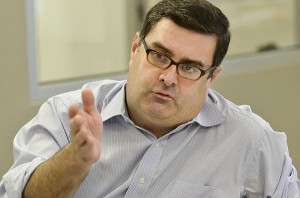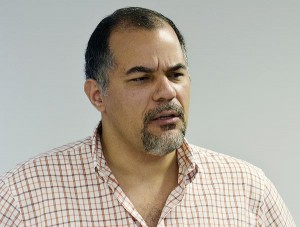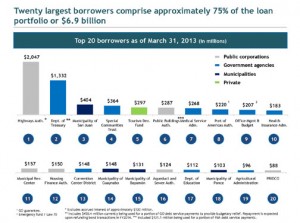CNE: Puerto Rico ‘failing to face new reality’


Sergio M. Marxuach, director for policy development at the Center for the New Economy. (Credit: © Mauricio Pascual)
Puerto Rico may have reached the limits of sustainable growth within its current institutional framework and its leaders must find the political will to make profound changes to the socioeconomic structure to pull out of the seemingly unstoppable downward spiral the island is on and insert it squarely into the new globalized economy.
However, changes must come about quickly to take advantage of the high point in the globalization cycle and international trade, investment, and financial flows, as well as migratory movements that are currently exploding.
“The pressing challenge is to think about how Puerto Rico can insert itself in these global flows. Yet, policymakers in Puerto Rico remain either oblivious to, or willfully ignorant of, this new reality,” said Sergio Marxuach, director for policy development at the Center for a New Economy, a local think-tank that on Wednesday presented its analysis of the recommended budget for Fiscal 2014.
The independent nonprofit group spent a month taking a close look at, and conducting a careful analysis of, the numbers, which clearly show a gap in revenue and expenditures that leave virtually no wiggle room for improvement.
“In the 15 years that I have been with the CNE, I’ve never been as worried about Puerto Rico’s economic situation as I am today,” said Mike Soto-Class, CNE president.
“We continue to do the same things over and over again, with the same committees with the same people from 30 years ago. Leaving everything for the last minute. Submitting the same proposals and arguments. Apparently, we’re expecting a different result and that’s not going to happen,” he said.
During a sit-down with members of the media, Marxuach picked apart the major points of the proposed $29 billion consolidated budget presented by Gov. Alejandro García-Padilla and his economic team in mid-April.
He bumped the current numbers up against the 2010 budget following the standard metric of comparing figures in four-year cycles.
“It’s an austere budget, when compared to 2010’s, reflecting a 1 percent increase,” Marxuach said.
Running the Puerto Rico government costs about $10 billion a year, which is part of that consolidated budget that is assigned to the General Fund. However, for the past several years, the island has fallen short in shoring up enough revenue to cover that expense, barely reaching $8 billion a year.
‘Running out of flexibility’
“We’re running out of flexibility to cover that gap. We have to make a decision as a country: if we want world-class services and education, we have to pay for them. If we can not spend on that, then we have to make adjustments,” he said. “You can’t buy a Ferrari with the money you have set aside for a Toyota, you’re just not going to have enough.”

“In the 15 years that I have been with the CNE, I’ve never been as worried about Pueto Rico’s economic situation as I am today,” said Mike Soto-Class, CNE president. (Credit: © Mauricio Pascual)
One of the solutions to that problem is finding recurring income. However, in a recession — or a depression — such as the one the island has been experiencing for the better part of the last eight years, it is a nearly impossible task to undertake.
“The easy sources of recurring income have run out and that’s why the government now is looking for ways to impose new taxes,” Marxuach said.
In the budget, the García-Padilla administration proposed a series of measures that it believes will generate more than $1 billion in new revenue, stemming from taxing business-to-business services, eliminating exemptions to resellers and increasing “sin taxes,” among other steps.
At present, those proposals are under scrutiny at the legislature, in a last-ditch attempt at coming up with a concrete budget and solutions by the June 30 deadline.
And with credit ratings agencies breathing down the Commonwealth’s neck, those in charge have to step it up, he said.
“I’m concerned that what may come out of the House is neither here nor there, full of patches, complex, difficult to monitor and enforce and that it fails to lift what it must lift in a weak economy,” Marxuach noted.
And with the looming possibility of a downgrade of the island’s credit to junk, any proposal coming out of the administrative spheres must be cohesive. Marxuach quoted UBS analysts in New York who have said there is a high probability that Moody’s, S&P and Fitch will likely cut the island’s general obligation credit to junk status by December. However, he does not believe it will happen in June.
“If there’s a downgrade, it will have repercussions and implications in the United States, because most of the debt is held there,” Marxuach said.
Debt equals GNP
Since fiscal year 2000, Puerto Rico’s total public debt has exploded both in absolute terms and relative to the size of the economy. At the end of fiscal year 2000, Puerto Rico’s public debt amounted to some $24.2 billion, while as of June 2012 it amounted to $69.9 billion, an aggregate increase of $45.7 billion, or 188.8 percent.
During this period, public indebtedness increased at a compound annual growth rate of 9.25 percent, the CNE said.
Meanwhile, Puerto Rico’s Gross National Product, at current prices, increased from $41.4 billion in 2000 to an estimated $69.5 billion at the end of fiscal year 2012, an aggregate increase of $28.1 billion, or 67.9 percent. During this period Puerto Rico’s GNP increased at a compound annual growth rate of 4.4 percent, or less than half of the pace with which the debt grew.
“Given that Puerto Rico’s indebtedness has grown at an average annual rate that is 2.1 times faster than the growth rate of its GNP during the last 12 years, it should not be surprising that Puerto Rico’s total public debt currently equals its GNP,” the CNE said in its analysis.
Puerto Rico’s public debt almost tripled during the period between 2000 and 2012. Each of the last three administrations added an average of $15 billion to Puerto Rico’s public debt.
“It is highly unlikely, however, that the García-Padilla administration will be able to repeat that feat,” he said, because the government has maxed out its lending sources. “In our view, Puerto Rico’s levels and rates of indebtedness are not sustainable. Puerto Rico desperately needs to ‘grow the denominator,’ that is, to reignite robust economic growth.”

Twenty largest borrowers comprise approximately 75 percent of the GDB’s loan portfolio, or $6.9 billion
Puerto Rico’s top debtors
The Government Development Bank, meanwhile, is sitting on the brink of insolvency because most agencies — and certain municipalities — owe millions. Of particular concern is the $2.2 billion debt owed by the Puerto Rico Highway and Transportation Authority, which could render the bank insolvent in case of a default.
If that problem is not solved, the GDB could itself be subject to a downgrade below investment grade, which could potentially trigger a domino effect on all other credit, with the exception of the Puerto Rico Sales Tax Financing Corporation (known as COFINA) and perhaps the general obligation bonds, Marxuach said.
However, that albeit grim scenario could arm the government with the leverage it needs to negotiate with bondholders — whose debt is protected by the Commonwealth’s Constitution — to bring down its obligation, he said.
In its analysis, the CNE provided a breakdown of the top 20 agencies and municipalities that owe the central government the most. After the Highway Authority, the list includes the Treasury Department, with $1.3 billion in debt, the Municipality of San Juan ($404 million), the Special Communities Trust ($364 million) and the Tourism Development Fund ($297 million.)















The problem in Puerto Rico is that Garcia-Padilla needs “cojones.”
As the governor, it’s up to him to make the tough decisions and
EDUCATE people about what needs to be done. It was a very,
very big mistake to start off dismissing Fortunio’s PPP projects.
Now, even if they are introduced in the market, investors will be
suspicious and head elsewhere. Even if you didn’t agree with
Fortunio, at the very least, he brought those on the outside to
look at Puerto Rico. The island is down it’s final stretch. Garcia-
Padilla needs to keep his eye on credit ratings and if those credit
agencies want less government, then that’s what he should give
them. The number of government offices that are similarly the
same (and redundant) except for maybe one word in the name,
is outrageous. And, it’s gone on for too long. Recently, there
was an article about CPA’s celebrating some anniversary. WELL,
WHERE IN GOD”S NAME ARE THEY? They and all the local
economists, on their soap boxes, should be leading “the charge,”
WITHOUT PAY, to save what’s left of Puerto Rico. GET WITH IT
ALREADY. YOU”RE MAKING THE ISLAND LOOK BAD TO THE
REST OF THE WORLD.